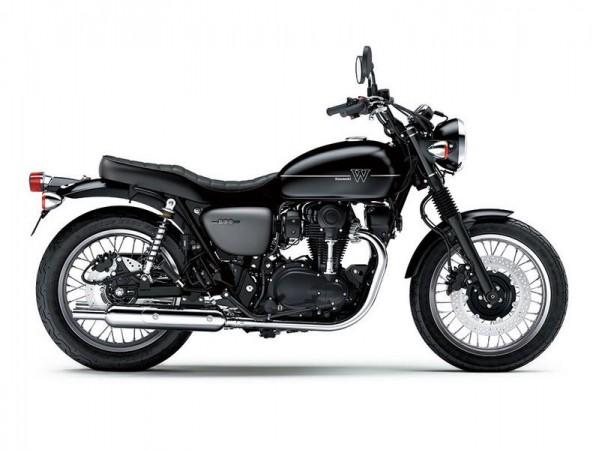Yes, you read that right. The Kawasaki W800 is the only production motorcycle in the world right now that employs a shaft-and-bevel-gear system to rotate its camshaft. What's special about it; how it functions; what are its pros and cons, and other questions around it shall be taken when we review the motorcycle. Until then, it would suffice to say that, among other motorcycles, the legendary Norton Manx also used shaft and bevel gears to spin its SOHC (Single Overhead Camshaft).
If you do not know what a "Norton Manx" is, without googling, or going to the previous hyperlink, then you may close this tab right away and buy something soulless, such as an electric motorcycle from Revolt Motors. On second thoughts, you may wait, because I shall also talk about Facebook and Instagram pictures in a while.

Back to the Kawasaki W800 now. The BS4 motorcycle used to cost Rs 7.99 lakh earlier, and it has to be said that Kawasaki did the unthinkable and launched the BS6 bike at Rs 6.99 lakh—a full lakh rupees less! It still retains its 773 cc, air-cooled, four-stroke, SOHC, four-valve per cylinder, fuel-injected, parallel-twin engine that produces 52 PS of peak power at 6,500 rpm and 62.9 Nm of peak torque at 4,800 rpm. Its main competitor, the Triumph Bonneville T100 produces 55 PS at 5,750 rpm and 76.73 Nm at 3,050 rpm. The Street Twin is even better—65 PS at 7,500 rpm, and 80 Nm at 3,800 rpm.
However, horsepower and torque are not really the topmost priorities of buyers of such motorcycles—"retro charm" and "easy-to-ride" are. While I'll let YOU decide which one of these three best takes care of the former, I'll provide my insights on the latter. Please note that I usually don't make definitive statements about a vehicle without reviewing it, however, I can stick my neck out this once and tell you that at a super low 8.4:1 compression ratio (Bonnie's is 10.55:1, and Street Twin's is 11.0:1), this Kawasaki, despite being air-cooled, should run a lot cooler than what some air-conditioners are managing in Delhi at present. That was an exaggeration, of course, but what can't be disputed is that Kawasaki gave it that kind of compression ratio to ensure it lives a more stress-free life than a lifelong vacationer in Bali. A stress-free life for an engine means "longevity". Just like us humans, then.

Talking about humans, even the shortest amongst us won't be anxious to swing a leg over the W800, thanks to its low seat height of 770 mm. Since we are continually comparing the Kawasaki W800 with the Bonnie and Street Twin, you must know that it's the Street Twin whose seat height is the friendliest (760 mm) in the segment for shorter folks. The Bonnie's is not bad either at 785 mm. Like I hinted in my RE Himalayan 650 story, anything up to a maximum of 800 mm is good enough for shorter riders.

This Kawasaki's fully fuelled (15 L) weight is 224 kg, which is more or less on a par with the two Triumphs. The dry weight figures listed by Triumph for the Street Twin and T100 are 198 kg and 213 kg, respectively. Add all liquids, battery, and a full tank (12 L for the Street Twin and 14.5 L for the Bonnie) of fuel, and the Bonnie would get heavier than the Kawasaki, but the Street Twin will still be the lightest.

The brakes would be another thing (in addition to the price) for a W800 owner to upset his Triumph-riding friends. Kawasaki has given a 320 mm rotor at the front (310 mm units in the Triumphs) and a massive-for-the-segment 270 mm disc at the rear (the Triumphs' are 220 mm ). The gearboxes in all three bikes are 5-speed units, so friendships will be resumed.

Triumph has been considerate enough to announce last month itself that it will not increase the prices of its BS6 motorcycles until July this year. As of now, the Bonnie T100 costs Rs 8.87 lakh while the Street Twin at Rs 7.45 lakh remains the most affordable Triumph. All prices mentioned in this story are ex-showroom.
And, well, that's about it. If you're still waiting for me to talk about Facebook and Instagram pictures, I lied.









!['Had denied Housefull franchise as they wanted me to wear a bikini': Tia Bajpai on turning down bold scripts [Exclusive]](https://data1.ibtimes.co.in/en/full/806605/had-denied-housefull-franchise-they-wanted-me-wear-bikini-tia-bajpai-turning-down-bold.png?w=220&h=138)



![India Auto Roundup: Maruti Suzuki, Mahindra have exciting launches in November [details here]](https://data1.ibtimes.co.in/en/full/805520/india-auto-roundup-maruti-suzuki-mahindra-have-exciting-launches-november-details-here.jpg?w=220&h=135)